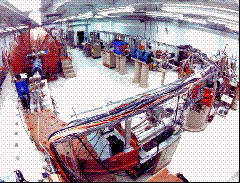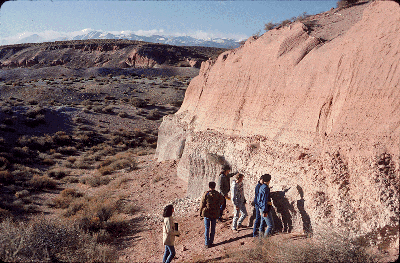
The information below was taken from the Web sites for these facilities. If you wish further information, click on a user facility name, and you will be taken directly to its Web page.
Center for Accelerator Mass Spectrometry (CAMS)
he Center has developed a wide range of isotopic and ion-beam analytical tools for use in basic research and technology development. CAMS has reached full operational status for eight cosmogenic or anthropogenic isotopes. It now routinely measures the low abundance (i.e. 1 part in 1012 to 1015) isotopes, 3-H, 7,10-Be, 14-C, 26-Al, 36-Cl, 41-Ca, and 129-I to very high degrees of accuracy. Switching is done among these isotopes on a daily basis (or at shorter intervals if necessary).
Research programs at the Center are both multidisciplinary and multiorganizational. As a national laboratory facility, all of the Center's capabilities are available to all qualified users under standard DOE procedures. Many academic and research organizations access the Center through collaborative research projects. The Center is located at Lawrence Livermore National Laboratory.

| Click the image to see a wide-angle view of the Center's FN tandem accelerator and mass spectrometer.
|
Center for Isotope Geochemistry
The analytical facilities of the Center are designed to provide the capabilities for measuring isotopic and trace element concentrations of rocks, minerals, and groundwaters. These measurements can be used to deduce the age of groundwater, the flow directions, the rate at which the groundwater chemistry changes by reaction with surrounding rocks, and also the age and origin of the rock units themselves. The Center's Radiogenic Isotope Laboratory has capabilities for high-precision isotopic and elemental abundance measurements of K, Ca, Sr, Nd, Pb, U, and Th using conventional thermal ionization mass spectrometry. The Noble Gas Laboratory is a facility with capabilities for high-precision isotopic and elemental abundance measurements of the five stable noble gas elements (He, Ne, Ar, Kr, and Xe) as contained in fluids, rocks, and minerals.
he Stable Isotope Laboratory has facilities for preparing and measuring the stable isotope ratios of H, C, N, O, and S using gas source isotope ratio mass spectrometry. The Cosmogenic Radionuclide Laboratory is a facility designed for chemical isolation of extremely small quantities (~105-106 atoms/gm-SiO2) of cosmogenic nuclides (10Be, 14C, 26Al, 36Cl, 41Ca, 59Ni, and 129I) produced in rocks and minerals exposed to the flux of high energy primary and secondary cosmic-ray particles. The Center is located at Berkeley Lab.

Ash deposits formed during the climactic eruption of the Long Valley volcanic system near Mammoth Lakes, California about 750,000 years ago. Researchers at the Center for Isotope Geochemistry are studying the volcanic formations of Long Valley to try to determine whether there can be another catastrophic eruption.
88-Inch Cyclotron
 The 88-Inch Cyclotron is a sector- focused cyclotron fed by two Electron Cyclotron Resonance (ECR) high-charge-state ion sources that enable the production of heavy ion beams from helium to neon with energies up to 32 MeV/nucleon. For heavier ions the maximum energy per nucleon decreases with increasing mass. In addition, intense light ion beams of isotopes of hydrogen and helium as well as polarized beams are available. Several beams are run commonly and efficiently from enriched source feed, including 18O and 22Ne, and 36S and 48Ca. In addition, the Cyclotron produces "cocktails" (mixtures of beams) for detector calibrations and applied work. The flexibility of the 88-Inch Cyclotron in running both light and heavy ions, as well as the cocktail beams, creates a very versatile facility. The Cyclotron is also the site of the Gammasphere, a high-resolution gamma-ray detector array. The Cyclotron is located at Berkeley Lab.
The 88-Inch Cyclotron is a sector- focused cyclotron fed by two Electron Cyclotron Resonance (ECR) high-charge-state ion sources that enable the production of heavy ion beams from helium to neon with energies up to 32 MeV/nucleon. For heavier ions the maximum energy per nucleon decreases with increasing mass. In addition, intense light ion beams of isotopes of hydrogen and helium as well as polarized beams are available. Several beams are run commonly and efficiently from enriched source feed, including 18O and 22Ne, and 36S and 48Ca. In addition, the Cyclotron produces "cocktails" (mixtures of beams) for detector calibrations and applied work. The flexibility of the 88-Inch Cyclotron in running both light and heavy ions, as well as the cocktail beams, creates a very versatile facility. The Cyclotron is also the site of the Gammasphere, a high-resolution gamma-ray detector array. The Cyclotron is located at Berkeley Lab.

